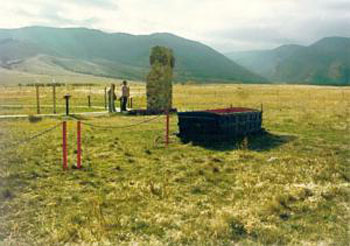
History
On August 2, 1867, Captain Powell and his company of soldiers were once again in the foothills of the Big Horns, guarding the civilian wood crews. When they had arrived at their site a few days before, the cautious Powell's first task was to create a defensible position. He did this by taking the boxes off some of his wagons, arranging them in a circle in an open area, and piling sacks of grain on top. The wagon carriages were then dragged across the openings between boxes. Powell's men carried brand new .50 caliber Springfield breech loading rifles, one tangible benefit of the Fetterman fiasco. Early that morning 1500 to 2000 Lakota under the leadership of Red Cloud and Crazy Horse had infiltrated the woods surrounding the camp. When two men entered the woods looking for fresh game, they glimpsed Lakota warriors instead. In the first scramble for safety, everyone who could made a break for Fort Phil Kearny, a little more than five miles away. Three or four men were killed outright; thirty-two men, including Captain Powell, took refuge inside the wagon box circle. The war party turned the full force of its anger on this tiny group. As they waited for the battle to begin in earnest, Captain Powell took a position at one end and Lieutenant John Jenness took the other. Poor shots were ordered to reload for the others. At 8:00 a.m. the first wave of about 500 Lakota rushed the wagon box circle. (The Indians frequently attacked in waves, a strategy designed to take advantage of lulls in the shooting caused by the time it took to reload the old rifles -- they had not yet encountered the new rifles.) Powell held his order to fire until the Lakota were very close, and the surprising barrage Powell's men unleashed drove the first wave back, and three or four successive waves as well. At one point, however, warriors made it to within five feet of the wagon boxes before they were shot down. Around noon, the Lakota massed for a direct assault. Their sheer numbers would surely have won the day, but reinforcements from Fort Phil Kearny arrived just in time, a howitzer in tow, and the Lakota vanished, taking their dead with them. They later admitted to having lost 50 to 60 braves. The soldiers estimated that they had killed hundreds. Of the thirty-two men inside the wagon box fort, only three were dead.
Location
Fort Phil Kearny State Historic Site. Explore the foothills of the Big Horn Mountains where Lakota and Cheyenne Indians fought to keep their last great buffalo hunting grounds. Walk the parade ground where soldiers once prepared for battle, then follow the interpretive trails at Fetterman Battlefield and the Wagon Box Fight Site.
Fort Phil Kearny State Historic Site is located just twenty miles south of Sheridan on Interstate 90, Exit 44. At the fort location the visitor will find an interpretive center with exhibits, videos, bookstore, and self-guided tours of the fort and outlying sites. The fort tour leads the visitor through the site to building locations, archaeological remains, and interpretive signs pinpointing the surrounding historic landmarks. A Civilian Conservation Corp. Cabin has been refurbished to depict the quarters of an Officer’s wife and a Non-Commissioned Officer’s Quarters. In addition to the historic interpretation, this site provides three picnic areas and a restroom for visitor use.
The two satellite sites of Fort Phil Kearny are the Fetterman Fight and the Wagon Box Fight battlefields. These two sites are located within a five-mile radius of the Fort Phil Kearny Visitor Center. Maps to the sites and interpretation are available at the Visitor Center. At both battlefields, the visitor will find an interpretive trail which leads through the battle providing both Indian and White perspectives of the conflict. The visitor can go to the actual locations of the skirmish lines and Indian charges and see the weapons and personnel involved. The Wagon Box Fight site provides the visitor with restroom facilities; also a picnic area where they may relax and enjoy the beautiful scenery.
All interpretive trails and facilities are either partially or fully accessible for the ADA. Guided tours of these three sites for social groups, schools, or special events may be scheduled through advance reservation. |